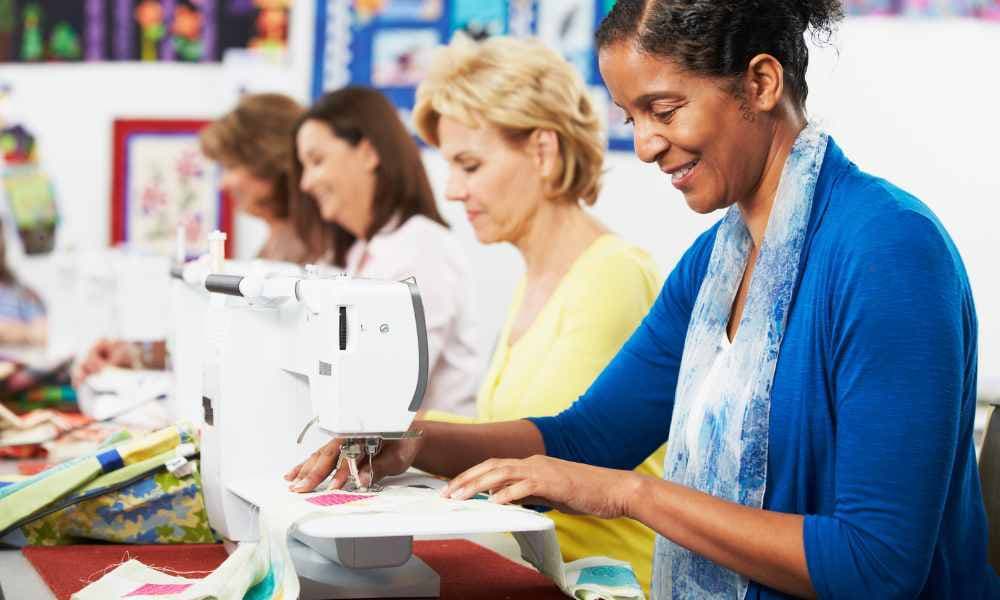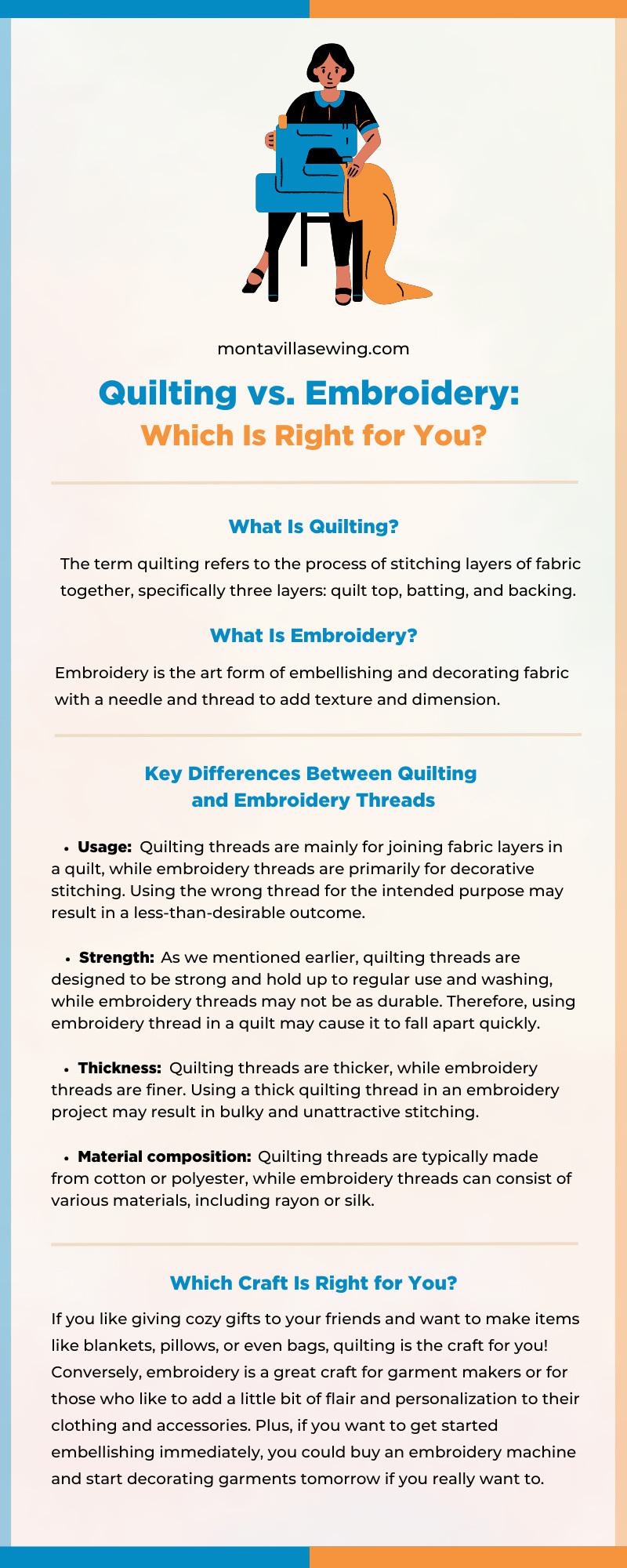Montavilla Sewing Blog

Quilting vs. Embroidery: Which Is Right for You?
November 27, 2023
Since the dawn of the sewing machine, sewing has become more easily accessible to those looking to express themselves through this art form. Today, people can create any number of crafts thanks to the myriad of sewing machines on the market. Anyone can turn on a sewing machine and learn to make garments, quilts, accessories, home decor, and so much more.
Two of the most popular forms of sewing are quilting and embroidery—both are styles that create fabulously intricate pieces, but they’re not quite the same. If you have difficulty distinguishing between the two, let’s look at quilting versus embroidery so you can determine which is right for you and start your own project.
What Is Quilting?
The term quilting refers to the process of stitching layers of fabric together, specifically three layers: quilt top, batting, and backing. The quilt top is, as the name states, the very top of the blanket and has all the beautiful designs and patterns. The batting is the insulating center of the quilt and can be cotton, wool, polyester, or even bamboo. The backing is the final layer and is typically one solid piece of fabric; it should be the same material as the quilt top. Think of a quilt as a sandwich with your batting in the middle.
What Is Embroidery?
Embroidery is the art form of embellishing and decorating fabric with a needle and thread to add texture and dimension. With embroidery, you have a wide range of project options and can embellish a variety of fabrics. You can decorate pillow covers, linens, napkins, bags, hats, umbrellas, and more. You’re not limited to embellishing with just thread, either, as you can incorporate other decorative materials, like beads, sequins, feathers, pearls, and other materials.
Embroidery vs. Quilting Machines
Embroidery machines can come either in a free-motion model or a computerized model. A free-motion embroidery machine lets you move the fabric around in any direction, while computerized machines are computer-controlled and will stitch the design for you. If you want to do free-motion embroidery, you can use a sewing machine to do so.
The same goes for quilting machines. You can absolutely use a regular sewing machine to make quilts, but quilting machines make the task easier and faster. This is because quilting machines are meant for bigger projects and will typically have more workspace, an extension table, and a faster stitching mechanism.
Quilting vs. Embroidery Threads
Quilting Threads
Quilting threads are primarily used for joining layers of fabric together in a quilt, creating the intricate patterns widely appreciated in quilting circles. The main characteristics of quilting threads include the following:
- Strength: Quilting threads are strong and durable to be able to withstand the constant folding, handling, and washing that quilts undergo.
- Material: Typically, quilting threads are 100 percent cotton or polyester or occasionally a blend of the two. They are considered low lint, meaning they produce minimal fluff that could interfere with the quality of your work.
- Weight: Most quilting threads are 40–50 weight, an ideal thickness for sewing through multiple layers of fabric without causing excess bulk.
Embroidery Threads
Embroidery threads, on the other hand, are primarily for use in decorative stitching on fabric, such as in monograms or intricate patterns. These threads differ from quilting threads in several critical aspects:
- Fineness: Embroidery threads are generally finer than quilting threads, allowing for more detailed stitching. The weight can vary greatly, depending on the desired embroidery effect.
- Material: Common embroidery thread materials include rayon, polyester, and silk. Each provides a distinct look and feel.
- Sheen: Many embroidery threads feature a high sheen, giving the finished embroidery project a lustrous and eye-catching appearance.
Key Differences Between Quilting and Embroidery Threads
While both quilting and embroidery threads serve different purposes, there are some key differences between the two:
- Usage: Quilting threads are mainly for joining fabric layers in a quilt, while embroidery threads are primarily for decorative stitching. Using the wrong thread for the intended purpose may result in a less-than-desirable outcome.
- Strength: As we mentioned earlier, quilting threads are designed to be strong and hold up to regular use and washing, while embroidery threads may not be as durable. Therefore, using embroidery thread in a quilt may cause it to fall apart quickly.
- Thickness: Quilting threads are thicker, while embroidery threads are finer. Using a thick quilting thread in an embroidery project may result in bulky and unattractive stitching.
- Material composition: Quilting threads are typically made from cotton or polyester, while embroidery threads can consist of various materials, including rayon or silk.
Which Craft Is Right for You?
You now know the main differences between quilting and embroidery and have gotten down to the nitty-gritty of threads, but which sewing project is right for you? The answer depends on what kind of creative experience you’re looking for and how you want to express yourself.
If you like giving cozy gifts to your friends and want to make items like blankets, pillows, or even bags, quilting is the craft for you! Conversely, embroidery is a great craft for garment makers or for those who like to add a little bit of flair and personalization to their clothing and accessories. Plus, if you want to get started embellishing immediately, you could buy an embroidery machine and start decorating garments tomorrow if you really want to.
If you can’t decide between the two, you can always include embroidery in your quilting. This way, you can add a little more texture and personalization to your quilts and practice both crafts.
If you need help with your first project or are ready to grab the materials you need to get started, visit Montavilla Sewing Centers today. We’re a sewing center in Portland, Oregon, that provides sewing machine equipment and accessories, sewing classes for different skill levels, and sewing machine repair services. When you leave our store, you’ll come out with everything you need to bring your dream project to life!
